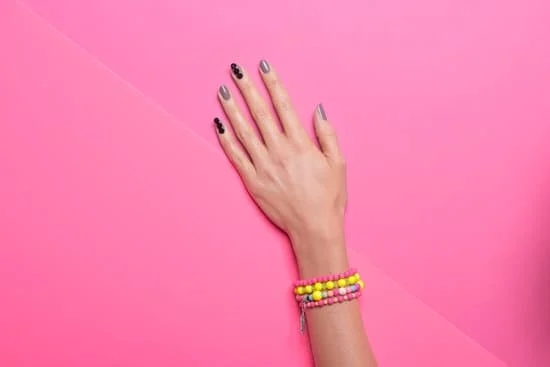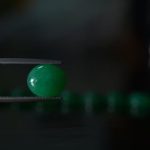Jewelry making is an art form that allows individuals to express their creativity and style through beautiful accessories. One essential technique in the world of jewelry making is crimping beads. Whether you’re a beginner or a seasoned jewelry maker, mastering the art of crimping beads is crucial for creating stunning pieces.
Crimp beads serve as the foundation of many types of jewelry designs, providing a secure and professional finish. From bracelets to necklaces, earrings to anklets, crimp beads offer versatility and endless possibilities. Learning this technique will give you the ability to create customized jewelry that perfectly reflects your personal style.
In this article, we will dive into the world of crimp beads in jewelry making. We will explore different types, sizes, and materials available in the market, as well as essential tools and supplies needed for successful crimping. Furthermore, we will guide you through the process of preparing beading wire and demonstrate the proper technique for using crimp beads effectively.
So join us on this creative journey as we delve into the fascinating world of crimp beads in jewelry making. Discover new techniques, troubleshoot common mistakes, and learn how to enhance your creations with stoppers or covers. By mastering this essential skill, you will have all the tools you need to bring your jewelry designs to life. Let’s get started.
Understanding Crimp Beads
Crimp beads are an essential component of jewelry making, as they provide a secure and professional finish to beading projects. In this section, we will explore the different types of crimp beads available in the market, discuss their sizes and how they impact the overall jewelry design, and delve into the materials used in crimp beads and their pros and cons.
Types of Crimp Beads
There are several types of crimp beads to choose from when it comes to jewelry making. The most common types include standard crimp beads, which are small metal tubes that are flattened with a crimping tool; tube crimps, which have a cylindrical shape that can be easily manipulated; and crimp covers or clamshells, which are used to conceal the flattened crimp bead for a more polished look.
Each type of crimp bead has its own advantages and considerations. Standard crimp beads are widely available and easy to use but may not offer as polished of a look compared to other options. Tube crimps provide a sleek appearance but require some practice to manipulate properly. Crimp covers or clamshells offer a professional finish but may add bulk to the design.
Sizes of Crimp Beads
When choosing the size of your crimp beads, it is important to consider both functionality and aesthetics. The size of the bead determines its strength in holding together the beading wire. Smaller beads are generally more appropriate for fine jewelry pieces or delicate designs where bulkiness is a concern. On the other hand, larger beads provide additional security, making them suitable for heavier pieces or designs that require added strength.
It’s crucial to select a size that corresponds well with your chosen beading wire thickness. A general guideline is matching the diameter of your wire with twice the diameter of your chosen crimp bead. This ensures a snug fit that securely holds the wire without slipping out.
Materials Used in Crimp Beads
Crimp beads are available in various materials, each with its own unique properties and considerations. The most common materials used in crimp beads include sterling silver, gold-filled, and base metal.
Sterling silver crimp beads are a popular choice for their durability and ability to withstand everyday wear. They also offer a high-end look but may be more expensive compared to other options. Gold-filled crimp beads provide the elegance of gold while being more affordable than solid gold alternatives. Base metal crimp beads are a budget-friendly option suitable for costume jewelry or projects where cost is a significant factor.
Consider your desired aesthetics, budget, and the intended purpose of your jewelry project when selecting the material for your crimp beads. It’s also important to be aware of any potential allergies or sensitivities to certain metals.
Understanding the different types, sizes, and materials of crimp beads is crucial for successful jewelry making. By considering these factors, you can make informed decisions that will contribute to the overall design and durability of your finished pieces.
Essential Tools and Supplies for Crimping Beads
In order to successfully crimp beads in jewelry making, it is essential to have the right tools and supplies. This section will introduce you to the necessary equipment and explain their specific purposes, highlighting their importance in achieving precise and professional crimps.
Tools for Crimping Beads
- Crimping Pliers: These specialized pliers are designed with two notches or indentations that allow you to create secure crimps. The first notch is used to flatten the crimp bead, while the second notch rounds it into a smooth shape. Make sure to invest in a high-quality pair of crimping pliers for optimal results.
- Wire Cutters: Wire cutters are essential for trimming excess wire from your jewelry projects. Look for sharp wire cutters that can cleanly cut through different types of beading wire, ensuring a neat finish.
- Round Nose Pliers: These pliers have rounded tips and are useful for bending and shaping wires. They come in handy when creating loops or making other decorative elements in your jewelry designs.
Supplies for Crimping Beads
- Crimp Beads: The main component of this technique, crimp beads are small metal beads made specifically for securing beading wire in place. They usually come in two types: round or tube-shaped, each with its own advantages and uses.
- Beading Wire: Choose a beading wire that matches the weight and flexibility required for your project. Beading wires come in different materials such as nylon-coated stainless steel, silver-plated copper, or tiger tail wire, each with unique characteristics suitable for specific designs.
- Bead Stoppers: These handy tools prevent your beads from sliding off the end of the wire while you are working on your design. Bead stoppers can save you time and frustration by keeping your beadwork secure.
Remember, investing in good quality tools and supplies is crucial for achieving precise and professional crimps. So, take the time to research and choose the right equipment that fits your needs. With the proper tools at hand, you’ll be ready to create stunning jewelry with beautifully crimped beads.
Preparing the beading wire
Selecting the Right Beading Wire
Before diving into crimping beads, it is important to choose the appropriate beading wire for your jewelry project. Beading wires come in various types and thicknesses, each serving a different purpose in jewelry making.
One of the most common types of beading wire is made from stainless steel or nylon-coated stainless steel. These wires are sturdy and flexible, making them suitable for most jewelry designs. Stainless steel wires are excellent options for heavy or large beads, while nylon-coated stainless steel wires offer extra protection against scratching and damage.
Another popular choice is tiger tail wire, which consists of multiple strands of stainless steel wire twisted together and coated with nylon. This type of beading wire provides more flexibility and durability compared to single-strand wires. It is ideal for delicate designs or when you want to create a floating illusion with beads.
Additionally, there are specialized beading threads like silk or nylon that work well with stringing pearls or other fine beadwork. These threads provide a soft drape and complement the elegance of certain jewelry pieces.
Measuring and Straightening the Wire
Once you have chosen the appropriate beading wire, it is crucial to measure and straighten it before starting the crimping process. Start by cutting a length of wire slightly longer than what you need for your design to allow room for adjustments during the crimping process.
To straighten the wire, gently pull it through your fingers or use a straightening tool specifically designed for beading wire. This step helps eliminate any kinks or bends in the wire that could affect the overall appearance of your finished piece.
After straightening, use a ruler or measuring tape to cut the beading wire to its desired length. It is recommended to leave an extra inch on each end for attaching clasps or other findings later on. Remember that it is always better to have more wire than you need, as it can be easily trimmed off if necessary.
Attaching Clasps and Findings
Now that your beading wire is measured and straightened, it’s time to attach the clasps or other findings to create a secure foundation for your jewelry piece. There are several techniques for attaching clasps, including using crimp beads, jump rings, or specialized connectors.
When using crimp beads to secure your clasps, slide a crimp bead onto one end of the beading wire. Then, thread the end through one side of the clasp or connector loop and back through the crimp bead. Make sure the beading wire forms a small loop before passing it through the crimp bead.
Using chain nose pliers or crimping pliers, grasp the crimp bead firmly and squeeze it shut to secure the connection. It should hold tightly and provide a neat finish. Repeat this process at the other end of the beading wire with the remaining clasp or finding.
By following these simple steps in preparing your beading wire, you will be able to design a solid foundation for your jewelry piece before moving on to the crucial technique of crimping beads. Taking time to select appropriate materials and ensuring proper measurements will greatly contribute to achieving a professional-looking result in your jewelry making endeavors.
Proper Technique for Crimping Beads
When it comes to jewelry making, mastering the crimping technique is essential for creating professional-looking pieces. Whether you are a beginner or an experienced jewelry maker, understanding the proper technique for crimping beads is crucial to achieving secure and durable jewelry designs. In this section, we will guide you through the correct method of using crimp beads in your jewelry making process.
There are two main methods for crimping beads: using standard crimp beads and tube crimps. Both methods require specific steps to ensure a strong and reliable hold on your beading wire.
Using Standard Crim Beads
- Slide a crimp bead onto your beading wire.
- Pass the beading wire through a jump ring or clasp (if desired) and then back through the crimp bead, creating a loop.
- Leave a small tail of about 0.5-1 inch of beading wire before the crimp bead.
- Use chain-nose pliers to flatten the crimp bead gently.
- Rotate the flattened crimp bead by 90 degrees and use the tip of chain-nose pliers to fold it in half.
- Gently squeeze the folded crimp bead with flat-nose pliers to secure it in place.
Using Tube Crimps
- Slide a tube crimp onto your beading wire.
- Pass one end of the beading wire through a jump ring or clasp (if desired) and then through the tube crimp, creating a loop.
- Bring both ends of the beading wire back into the tube crimps, ensuring that they meet in the middle.
- Use chain-nose pliers to flatten both sides of the tube crimps simultaneously.
- Rotate the flattened tube crimps by 90 degrees and use the tip of chain-nose pliers to fold them in half.
- Gently squeeze the folded tube crimps with flat-nose pliers to secure them in place.
It is important to note that whether you are using standard crimp beads or tube crimps, you should always test the strength of your crimps by tugging on the beading wire before proceeding with your design. If the crimp gives way or slides along the wire, it needs to be adjusted or redone.
By following these step-by-step instructions and practicing, you will become proficient in the technique of properly crimping beads. Remember, practice makes perfect.
Troubleshooting Common Mistakes in Crimping Beads
When it comes to crimping beads in jewelry making, it is common for beginners to make mistakes. However, with practice and a clear understanding of the process, these mistakes can easily be resolved. In this section, we will identify some common errors or challenges that arise during the crimping process and provide expert tips and tricks for avoiding them.
One common mistake that jewelers make is ending up with loose crimps. This can happen if the crimp bead is not compressed enough. To avoid this, it is crucial to use proper tools such as crimping pliers or crimping forceps. These tools ensure precise pressure on the crimp bead to create a secure hold. Additionally, using quality crimps made of brass or sterling silver will provide better results compared to cheaper alternatives.
Another challenge faced by many jewelers is working with damaged wires. It is important to inspect the wire for any weakness or damage before starting the crimping process. If there are any bends or kinks in the wire, it may affect the overall strength of the finished piece. To prevent this from happening, take extra care when handling and storing your beading wire.
Misshapen beads are another common issue encountered during crimping. This usually occurs when too much pressure is applied during compression, causing the bead to flatten unevenly or lose its shape altogether. To avoid misshapen beads, start by compressing gently and gradually increase pressure until you achieve a tight hold without distorting the shape of the bead.
| Common Mistake | Solution |
|---|---|
| Loose Crimps | Use proper tools like crimping pliers |
| Working with Damaged Wires | Inspect the wire for any weakness or damage before crimping |
| Misshapen Beads | Apply gradual pressure and avoid over-compression |
By being aware of these common mistakes and knowing how to address them, you can ensure that your crimped beads are securely held in place and the overall integrity of your jewelry piece is maintained. Practice these troubleshooting techniques to achieve flawless results in your crimping endeavors.
Enhancing Crimped Beads
In the world of jewelry making, crimp beads are an essential component for securing beads onto beading wire. However, to take your designs to the next level and add that extra touch of professionalism and style, incorporating stoppers and covers into your crimped beads can make a significant difference. Stoppers and covers not only enhance the finished look of your jewelry but also provide functional benefits such as preventing beads from slipping off or hiding unsightly crimps.
When it comes to adding stoppers and covers, there are numerous options available depending on your design preferences. One popular choice is using crimp bead covers, which are small metal beads that can fit over the crimped bead, giving it a polished appearance. These covers come in various shapes, sizes, and finishes such as silver, gold, or copper. They can easily be slipped over the crimp bead using a pair of jewelry pliers.
Another option is using bead tips or clamshell findings as stoppers for your crimped beads. These findings have a loop or hook at one end where you can attach clasps or jump rings for easy closure. Bead tips not only secure your beading wire but also add elegance to your designs with their decorative designs and finishes. They can be found in different materials such as stainless steel, sterling silver, or even colorful plastic.
To give a finished look to your designs while still allowing flexibility in size adjustments, you may consider using French wire or bullion wire. This fine coiled wire acts as a protective covering between the beading wire and the clasp while providing an elegant touch. Simply thread the French wire onto the beading wire before adding the clasp and use crimp beads at both ends to secure it in place.
Incorporating stoppers and covers into your crimped bead designs allows you to not only ensure the security of your jewelry but also add an element of style and professionalism. Experiment with different types of stoppers and covers to find the ones that complement your design aesthetic, whether it’s delicate and minimalist or bold and statement-making. By mastering the art of incorporating stoppers and covers, you can elevate your jewelry creations to new heights.
| Options | Description |
|---|---|
| Crimp bead covers | Small metal beads that fit over crimped beads for a polished look. |
| Bead tips / Clamshell findings | Findings with loops or hooks that secure beading wire and add elegance. |
| French wire / Bullion wire | Fine coiled wire that protects beading wire, adds elegance, and allows flexibility in size adjustments. |
Finishing Touches
After painstakingly designing and creating a beautiful piece of jewelry using crimp beads, it is crucial to ensure that the finishing touches are done properly to secure and conceal the crimps. This step not only improves the overall appearance of the jewelry but also enhances its durability. In this section, we will guide you through the process of securely finishing your crimped beads and provide tips for achieving a professional-looking result.
One method for securing crimp beads is by using a crimp cover. A crimp cover is a small metal bead that can be slipped over the crimped bead to hide it while adding an elegant touch to your design. To use a crimp cover, simply thread it onto your beading wire before attaching the clasp or jump ring.
After securing the ends of your jewelry piece with a crimp bead, position the crimp cover over the crimped bead and gently close it using flat-nose or chain-nose pliers. Pressing down on both sides of the cover will cause it to encapsulate the crimped bead, effectively hiding it from view.
Another method for concealing and securing your crimps is by using bead tips or clamshell findings. Bead tips are tiny cups with loops that can be attached to one end of your jewelry piece without needing any additional tools. These findings can then be connected to a clasp or jump ring, offering a neat and professional finish.
Similarly, clamshell findings are two-part components that enclose your finished ends like a shell would. Simply thread one part onto your wire before adding your final beads, then thread on the other part after completing your design. To secure these findings in place, gently squeeze them shut with pliers.
In addition to these methods, you can also add extra security by incorporating wire guardians or coil covers into your design. Wire guardians are small metal loops that can be threaded onto your beading wire at each end to protect it from abrasion caused by repeated movement.
They not only offer protection but also give a polished look to your jewelry. Coil covers, on the other hand, are spiral-shaped findings that can act as a shield between your crimped beads and the rest of the design, preventing any snagging or scratching.
Remember, taking the time to properly secure and conceal your crimp beads will ensure that your jewelry withstands daily wear and tear while maintaining its professional appearance. Experiment with different finishing techniques and find what works best for each design. With practice and attention to detail, you can achieve flawless results and create stunning, high-quality jewelry pieces that will be admired for years to come.
Conclusion
In conclusion, mastering the technique of crimp beads in jewelry making is essential for creating stunning and professional-looking pieces. Throughout this article, we have explored the different types, sizes, and materials of crimp beads, as well as the necessary tools and supplies for successful crimping. We have also discussed the importance of preparing the beading wire properly and demonstrated the correct technique for crimping beads.
As with any skill, practice is key to becoming a master of crimp beads. By experimenting and honing your technique, you can discover endless possibilities for creating unique and personalized jewelry designs. Let your imagination run wild and don’t be afraid to try new techniques or incorporate stoppers and covers to enhance your finished pieces.
Remember to pay attention to detail and ensure your crimps are secure and concealed properly for long-lasting durability and a professional finish. Troubleshoot common mistakes that may arise during the process and learn from them to improve your skills.
With determination, practice, and creativity, you can become a master of crimp beads in jewelry making. The possibilities are endless when it comes to creating beautiful jewelry that truly reflects your style and personality. So go ahead, embrace this fascinating technique, and let your passion shine through in every piece you create.
Frequently Asked Questions
How do you crimp jewelry with beads?
Crimping jewelry with beads involves securing the beads in place using crimp beads or tubes. Begin by threading the beading wire through the clasp and then slide on a crimp bead, leaving a small tail of wire. Pass the tail back through the bead, creating a loop around the clasp.
Use a pair of flat nose pliers to flatten and compress the crimp bead, ensuring it is tightly secured. Trim any excess wire close to the flattened crimp bead. To hide the crimp bead, string your desired beads onto the wire and repeat this process at the other end of your design.
Can you crimp beads without a crimping tool?
While it is not ideal, you can still crimp beads without a specialized crimping tool. In the absence of a crimping tool, you can use flat nose pliers or chain nose pliers instead to secure your crimps.
Follow similar steps as mentioned before, but instead of using a dedicated crimper’s jaws on your tool, use flat or chain nose pliers’ jaws to carefully flatten and compress the crimp bead. Ensure that you apply even pressure to compress it fully without distorting or damaging it.
What tool do you use to crimp beads?
The primary tool used for crimping beads is called a crimping tool or crimper. This specialized tool has two sections within its jaws—an outer section and an inner section—that perform different functions during the process. The outer section forms grooves into which the crimp bead sits securely, while the inner section creates folds in these grooves when compressed with sufficient force.
This folding action tightly secures both ends of beading wire in place within one simple motion, providing a secure hold for your jewelry designs. Using this specific tool enables neat and professional-looking finishes when working with beaded jewelry projects involving crimps.

Welcome to my jewelry blog! My name is Sarah and I am the owner of this blog.
I love making jewelry and sharing my creations with others.
So whether you’re someone who loves wearing jewelry yourself or simply enjoys learning about it, be sure to check out my blog for insightful posts on everything related to this exciting topic!





